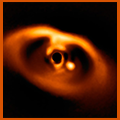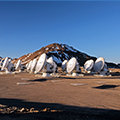Searching for objects and measuring the flux
As mentioned previously, the comparison between ALMA and VLA data are done for all the seven sources (HOPS-56B, HOPS-65, HOPS-124, HOPS-140, HOPS-157, HOPS-163, and HH270-MMS2) (Sheehan, 2020). The noise of the data is assumed to be normal distribution, so it is 99.7% confident to assume value above 3 times of root mean square (RMS) is real. If objects are found by the contours, the integrated flux of it will be calculated by using CASA after a Gaussian fit. If no objects are detected, 3 * RMS of the disk region will be used as the upper limit on the flux of potential sources. 3 types of results are expected: 1. Both primary star and secondary object are found and we measure fluxes for both of them. 2. Only the primary star is detected and we measure its flux and use the upper limit (3*RMS) for the flux of the secondary object. 3. No detections are found and we use the upper limit for both of them
calculating bolometric luminosity
Tychoniec (2018) finds that the radio luminosity is correlated with bolometric luminosity L_bol. To get it, we first corrected the flux densities for distance (0.4kpc) by Equation 1 and then Equation 2 is used to convert luminosity at the detection wavelength to 4.1 cm. Two type of relationships are used at this step. We derived L_bol, which is essential for finding mass.
\[L\propto v^{-1}\]
\[L\propto v^{0.51}\]
\[L=F*D^2\]
\[log(L_{4.1 cm})=(-2.66 \pm 0.06)+(0.91 \pm 0.06)log(L_{bol})\]
Calculating mass of the object with evolutionary tracks
By estimating the mass, question of whether they’re companion stars or planet can be answered. The method uses evolutionary tracks. Evolutionary tracks describe the relationship between the age, mass, bolometric luminosity( \[L\propto v^{0.51}\]), and effective temperature of a star. With two of them settled, the other two parameters can then be determined. We used 0.5 and 1 Myr as the assumed age of the disks. Besides, the tracks are only calculated at specific masses and ages, so to get values in between, interpolation is needed. This process mimicked the 2-dimentional interpolation process in pdspy python package



